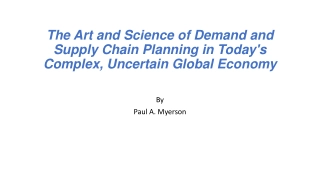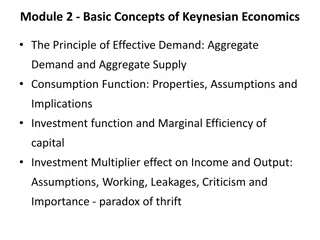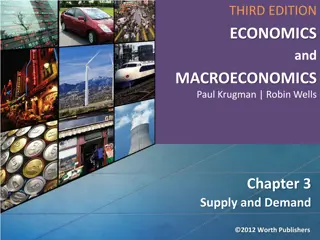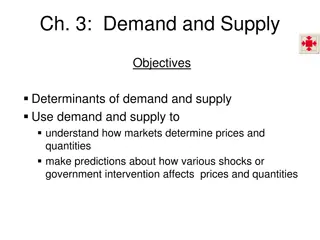
Understanding the Impact of Demand and Supply on Oil Prices
Explore the dynamics of demand and supply in relation to oil prices, delving into factors such as changes in economies, environmental awareness, and oil production levels. Discover why the price of oil has fallen, the benefits of reduced oil prices, and the implications for consumers. Gain insights into the interplay between demand and supply in the oil market and how it influences pricing trends.
Download Presentation

Please find below an Image/Link to download the presentation.
The content on the website is provided AS IS for your information and personal use only. It may not be sold, licensed, or shared on other websites without obtaining consent from the author. If you encounter any issues during the download, it is possible that the publisher has removed the file from their server.
You are allowed to download the files provided on this website for personal or commercial use, subject to the condition that they are used lawfully. All files are the property of their respective owners.
The content on the website is provided AS IS for your information and personal use only. It may not be sold, licensed, or shared on other websites without obtaining consent from the author.
E N D
Presentation Transcript
Demand and Supply
Demand and Supply If Demand increases and supply remains unchanged, a shortage occurs, leading to a higher price. If Demand decreases and supply remains unchanged, a surplus occurs, leading to a lower price.
Supply If Supply increases and demand remains unchanged, a surplus occurs, leading to a lower price. If Supply decreases and demand remains unchanged, a shortage occurs, leading to a higher price.
Demand and Supply In this powerpoint, you'll discover the effect of the changing relationship between demand and supply on prices. One example is oil prices. Back in June 2014, the price of crude oil was up around $115 per barrel. As of January 5, 2015, it had fallen by 50% down to $52 per barrel. But why does the price of oil keep falling?
Why has the Price of Oil Fallen? On The Demand Side, The economies of Europe have weakened due to recession and therefore are demanding less oil. People are becoming more environmentally aware. Vehicles are becoming more energy-efficient, so demand for fuel is falling. In China the demand for oil has fallen due to use of alternatives.
Why has the Price of Oil Fallen? On the Supply Side United States domestic production has nearly doubled over the last six years. Saudi, Nigerian and Algerian oil that once found a home in the United States is suddenly competing for Asian markets, and the producers are forced to drop prices. OPEC has not intervened to curb production and stabilise price.
Benefits of falling oil prices Households will spend less on energy this year because of the lower oil prices. Any motorist can tell you fuel prices have dropped considerably in recent months. The fall should lead to lower prices all around.
Negative effects Oil producing countries, however, will suffer as the prices continue to drop. Some smaller oil companies that are in debt may go out of business, which in turn will pressure banks that had to lend to them. It is also contributing to deflation.
Conclusion We can now see that the relationship between supply and demand can have a huge effect on prices and therefore on every part of the economy.






















